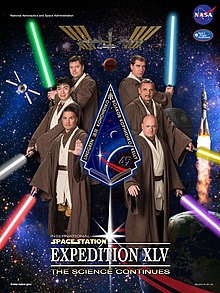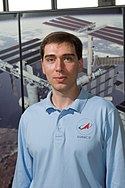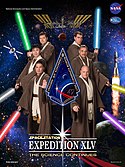Sergej Volkov
| Sergej Alexandrovič Volkov | |
|---|---|
 | |
| Kosmonaut CPK | |
| Státní příslušnost | Rusko |
| Datum narození | 1. dubna 1973 (49 let) |
| Místo narození | Čugujev, Ukrajinská SSR, SSSR |
| Předchozí zaměstnání | vojenský pilot |
| Hodnost | plukovník (2009, od 2012 v záloze) |
| Čas ve vesmíru | 547 dní, 22 hodin a 20 minut |
| Kosmonaut od | 26. prosince 1997 |
| Mise | Expedice 17 (Sojuz TMA-12/ISS) Expedice 28/29 (Sojuz TMA-02M/ISS) Expedice 45/46 (Sojuz TMA-18M/ISS) |
| Znaky misí | |
| Kosmonaut do | 28. února 2017 |
| Některá data mohou pocházet z datové položky. | |
Sergej Alexandrovič Volkov (* 1. dubna 1973 Čugujev, Charkovská oblast, Ukrajinská SSR, SSSR), původně vojenský pilot, je ruský kosmonaut ukrajinské národnosti. Jedná se o syna Alexandra Alexandroviče Volkova, bývalého vojenského pilota, kosmonauta v období 1976–1998 (3 lety, 391 dní v kosmu). Do vesmíru vzlétl třikrát, na dlouhodobé pobyty na Mezinárodní vesmírnou stanici (ISS) – poprvé roku 2008 jako člen Expedice 17, podruhé roku 2011 jako člen Expedice 28/29, potřetí v letech 2015/2016 jako člen Expedice 45/46.
Vzdělání, služba v letectvu
Sergej Volkov se narodil 1. dubna 1973 v Čugujevu, když jeho otec Alexandr Volkov sloužil jako instruktor v Charkovské vojenské vysoké letecké škole. Po třech letech se Alexandr Volkov stal kosmonautem a rodina se přestěhovala do Hvězdného městečka. Zde Sergej Volkov v roce 1990 dokončil střední školu. V roce 1995 vystudoval Tambovskou vojenskou leteckou vysokou školu M. M. Raskovojevové ( Тамбовское высшее военное авиационное училище летчиков имени Марины Расковой).[1]
Od března 1996 byl pilotem, poté byl starším pilotem a pomocníkem velitele letadla Il-76 v 8. letecké divizi zvláštního určení v Čkalovském (Moskevská oblast). Pilotoval letadla L-29 Delfín, L-39 Albatros, Tu-134, Il-22 a Il-76 s celkovým náletem cca 500 hodin.[1]
Kosmonaut
28. července 1997 byl mezirezortní komisí vybrán k zařazení do oddílu kosmonautů CPK, zařazen do oddílu kosmonautů byl 26. prosince téhož roku. V listopadu 1999 dokončil dvouletý všeobecný výcvik a získal kvalifikaci kosmonaut-výzkumník.[1]
Od ledna 2000 do července 2001 byl školen v rámci programu letů k ISS jako člen skupiny kosmonautů. Od září 2001 do února 2003 se připravoval jako velitel náhradní posádky (se Sergejem Krikaljovem a Paulem Richardsem, později Johnem Phillipsem) pro Expedici 7 na Mezinárodní vesmírnou stanici (ISS). V únoru – říjnu 2003 se ve stejné posádce připravoval k letu na ISS (let STS-114), po zrušení letů raketoplánů byla posádka rozpuštěna. V únoru 2004 byl zařazen do Expedice 11 na ISS, ale v lednu 2005 byl nahrazen Thomasem Reiterem. V únoru – březnu 2006 Byl náhradníkem prvního brazilského kosmonauta Marcose Pontese v 10. návštěvní expedici na ISS.[1]

Dne 6. listopadu 2007 byl schválen velitelem lodi Sojuz TMA-12 a Expedice 17 k ISS.[1] Kromě něj měli v letět Sojuzu TMA-12 i Oleg Kononěnko a první jihokorejský astronaut Ko San. Ko Sana však 10. března 2008 nahradila I So-jon.
Odstartoval v Sojuzu TMA-12 8. dubna 2008 s Olegem Kononěnkem a I So-jon. 10. dubna se Sojuz TMA-12 spojil se stanicí ISS.[2] Volkov s Kononěnkem převzali stanici od Peggy Whitsonové a Jurije Malenčenka a po jejich odletu s Korejkou na ní zůstali společně s Garrettem Reismanem. V červnu 2008 Reismanna nahradil Gregory Chamitoff. Během letu Volkov dvakrát vystoupil do vesmíru, celkem na 12 hodin a 12 minut. Po půl roce byli Volkov a Kononěnko vystřídáni dvojicí Michael Fincke, Jurij Lončakov a 24. října 2008 přistáli v Kazachstánu.[2]
V červenci 2009 bylo zveřejněno jeho jmenování členem hlavní posádky Expedice 28/29 se startem v květnu 2011.[1] V říjnu 2009 NASA jeho zařazení do Expedice 28 potvrdila.[3]

Podruhé do kosmu odstartoval v Sojuzu TMA-02M z kosmodromu Bajkonur 7. června 2011 v 20:13 UTC ve funkci velitele lodi společně se Satoši Furukawou a Michaelem Fossumem. Po dvoudenním letu se 9. června Sojuz spojil s Mezinárodní vesmírnou stanicí. Na ISS pracoval ve funkci palubního inženýra Expedic 28 a 29. Po 167 dnech letu s Fossumem a Furukawou přistáli se Sojuzem TMA-02M v Kazachstánu.[4]
V létě 2012 v rámci zcivilnění oddílu kosmonautů a CPK odešel z armády do civilu. Od srpna 2012 do dubna 2014 vykonával funkci náčelníka oddílu kosmonautů, předtím byl jeho zástupcem.[1]
V květnu 2013 byl jmenován velitelem Sojuzu TMA-18M, který odstartoval k ISS začátkem září 2015. Na stanici zůstal jako člen Expedice 45/46,[1] ostatní členové posádky Sojuzu – kosmonaut ESA Andreas Mogensen a Kazach Ajdyn Aimbetov se po několika dnech vrátili zpět na Zem v Sojuzu TMA-16M pod vedením velitele lodi Gennadije Padalky.
Na Zemi se vrátil v Sojuzu TMA-18M dne 2. března 2016 společně s Michailem Kornijenko a Scottem Kelly. Volkovův třetí let trval 181 dní, 23 hodin a 48 minut,[1] Kornijenko a Kelly strávili ve vesmíru 340 dní, 8 hodin a 43 minut.[5]
Od konce roku 2015 byl poslancem tambovské oblastní dumy za stranu Jednotné Rusko.[1]
K 28. únoru 2017 odešel z oddílu kosmonautů a ke konci března i ze Střediska přípravy kosmonautů.[1]
Sergej Volkov je ženatý, má dvě děti.[1]
Hodnosti
- 21. října 1995 – poručík
- 2. října 1996 – nadporučík
- 29. října 1996 – kapitán
- ? – major
- 16. prosince 2004 – podplukovník
- říjen 2009 – plukovník
- od 2012 v záloze
Vyznamenání
- Hrdina Ruské federace (5. února 2009),[1]
- Letec-kosmonaut Ruské federace (5. února 2009),[1]
- Řád Za zásluhy o vlast IV. třídy (2. února 2013),[1]
- Řád Dostyk II. třídy (3. prosince 2015; kazašský, Řád Družby),[1]
- Řád Za zásluhy o vlast III. třídy (2017).[1]
Odkazy
Reference
- ↑ a b c d e f g h i j k l m n o p q IVANOV, Ivan, a kol. Космическая энциклопедия ASTROnote [online]. Rev. 2011-04-18 [cit. 2011-06-23]. Kapitola Сергей Александрович Волков. Dostupné online. (rusky)
- ↑ a b HOLUB, Aleš. MEK. Malá encyklopedie kosmonautiky [online]. Praha: rev. 2008-10-31 [cit. 2011-06-23]. Kapitola Sojuz TMA-12. Dostupné online.
- ↑ YEMBRICK, John; CLOUTIER-LEMASTERS, Nicole. Release: 09-233. NASA and its International Partners Assign Space Station Crews [online]. Washington, Houston: NASA, 2009-10-07 [cit. 2011-06-23]. Dostupné online. (anglicky)
- ↑ HOLUB, Aleš. MEK. Malá encyklopedie kosmonautiky [online]. Praha: rev. 2011-06-10 [cit. 2011-06-23]. Kapitola Sojuz TMA-02M. Dostupné online.
- ↑ Ivanov. Rev. 2016-3-2 [cit. 2016-03-10]. Kapitola Михаил Борисович Корниенко. (rusky)
Externí odkazy
 Obrázky, zvuky či videa k tématu Sergej Volkov na Wikimedia Commons
Obrázky, zvuky či videa k tématu Sergej Volkov na Wikimedia Commons - ВОЛКОВ, Сергей. Почтовый ящик космонавтов МКС :Сергей Волков [online]. Moskva: Roskosmos [cit. 2016-03-10]. Blog Volkova v „poštovní schránce“ kosmonautů z ISS. Dostupné v archivu pořízeném dne 2016-03-11. (rusky)
Média použitá na této stránce
Russian Federal Space Agency cosmonaut Sergei Volkov, Expedition 17 commander, participates in a session of extravehicular activity (EVA) as construction and maintenance continue on the International Space Station. During the five-hour, 54-minute spacewalk, Volkov and cosmonaut Oleg Kononenko (out of frame), flight engineer, continued to outfit the station's exterior, including the installation of a docking target on the Zvezda Service Module.
The 46 icon in the foreground of the Expedition 46 patch represents the forty-sixth expeditionary mission to the International Space Station. The graphic portrays the limb of the home planet, Earth, with the black vastness of space in the background. Earth is depicted at the top with the flags of the countries of origin of the crew members: the United States of America, Russia and the United Kingdom. The flag of the U.K. is displayed in a position of prominence in recognition of the significance of the first British astronaut flown in space for the European Space Agency. The outer border is in the shape of a triangle with an unbroken border, symbolizing the infinite journey of discovery for past, present and future space explorers. The names of the six Expedition 46 astronauts and cosmonauts are shown in the border.
The Expedition 17 patch is meant to celebrate current human achievements in space as well as symbolize the future potential for continuing exploration. The Earth, represented at the bottom of the patch, is the base from which all space exploration activities initiate. The International Space Station (ISS), shown in low Earth orbit, illustrates the current level of space operations. The arrow and star point outwards, away from the Earth, towards the wider universe indicating the direction of future activities as human beings build on what has already been accomplished. The flags, representing the home countries of the crew members, Russia and the United States, are touching, highlighting the cooperative nature of the space program and symbolizing the merger of science and technical knowledge of these two experienced space-faring nations.
Cosmonaut Sergei Volkov, Russia's Federal Space Agency
The Expedition 45 crew poster pays tribute to the epic space opera film Return of the Jedi.
The Expedition 45 crew will conduct its journey of exploration and discovery from a summit whose foundation was built by past generations of pioneers, scientists, engineers and explorers. This foundation is represented by the book of knowledge at the bottom of the patch. Curves radiate from the book representing the flow of knowledge - and the hard work, sacrifice and innovation that makes human spaceflight possible. The pages written during Expedition 45 will serve to benefit humanity on Earth and in space. The International Space Station is represented by a single bright star soaring over the Earth, illuminating a path to future, more distant destinations.
In the foreground of the Expedition 28 patch, the International Space Station is prominently displayed to acknowledge the efforts of the entire International Space Station (ISS) team – both the crews who have assembled and operated it, and the team of scientists, engineers, and support personnel on Earth who have provided a foundation for each successful mission. Their efforts and accomplishments have demonstrated the Space Station's capabilities as a technology test bed and a science laboratory, as well as a path to the human exploration of our solar system and beyond. This Expedition 28 patch represents the teamwork among the international partners – USA, Russia, Japan, Canada, and the ESA – and the ongoing commitment from each partner to build, improve, and utilize the ISS. Prominently displayed in the background is our home planet, Earth – the focus of much of our exploration and research on our outpost in space. Also prominently displayed in the background is the Moon. The Moon is included in the design to stress the importance of our planet's closest neighbor to the future of our world. Expedition 28 is scheduled to occur during the timeframe of the 50th anniversary of both the first human in space, Russian cosmonaut Yuri Gagarin and the first American in space, astronaut, Alan Shepard. To acknowledge the significant milestone of 50 years of human spaceflight, the names "Гагарин" and "Shepard" as well as "50 Years" are included in the patch design.
On the Expedition 29 patch, the International Space Station (ISS) is shown following the path of the historic 18th century explorer, Captain James Cook, and his ship, Endeavour. During Cook's three main voyages, he explored and mapped major portions of the oceans and coastlines under the flight path of the ISS and added immeasurably to the body of knowledge of that time. As the ISS sails a stardust trail – following the spirit of Endeavour sailing toward the dark unknown and new discoveries – it enlightens Earth below. Through the centuries, the quest for new discoveries has been a significant element of the human character, inspiring us to endure hardships and separation to be part of a mission which is greater than any individual. A spokesman for the crew stated, "The crew of Expedition 29 is proud to continue the journey in this greatest of all human endeavors."







